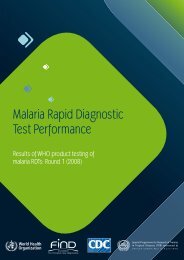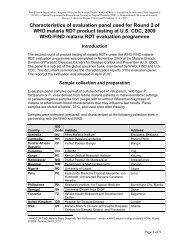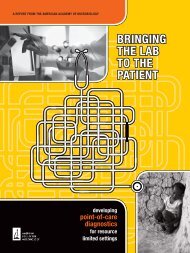Project Management Standard Operating Procedure
Project Management Standard Operating Procedure
Project Management Standard Operating Procedure
You also want an ePaper? Increase the reach of your titles
YUMPU automatically turns print PDFs into web optimized ePapers that Google loves.
<strong>Project</strong> <strong>Management</strong> <strong>Standard</strong> <strong>Operating</strong> <strong>Procedure</strong><br />
1. FIND QUALITY MANAGEMENT SYSTEM<br />
FIND is certified for “<strong>Project</strong> <strong>Management</strong> for Design, Development and Manufacturing of IVDs,<br />
Evaluation, Demonstration and Collecting Evidence for Scale-up, and Scale-up of IVDs” in compliance<br />
with international standards 13485:2003 (Medical Devices-Quality <strong>Management</strong> Systems-<br />
Requirements for Regulatory Purposes) and 9001:2008 (Quality <strong>Management</strong> Systems-<br />
Requirements); this certification extends to both of the FIND satellite offices in India and Uganda.<br />
FIND Quality <strong>Management</strong> System (QMS) is designed to ensure that ISO standards are implemented<br />
throughout all organizational processes and procedures. The Quality Manual is the principle quality<br />
procedure while the FIND project management strategy is described in a dedicated <strong>Standard</strong><br />
<strong>Operating</strong> <strong>Procedure</strong> entitled “<strong>Project</strong> <strong>Management</strong> SOP QP 05-00-01” (PM SOP). Compliance of all<br />
project-related processes with the PM SOP is a prerequisite for continuing FIND ISO certification.<br />
FIND is dedicated to a process of continuous improvement and review of its Quality <strong>Management</strong><br />
Systems and the objectives embodied in them. FIND senior management defines annual quality<br />
objectives and evaluates performance of the organization according to targets attained. Achievement<br />
of planned project milestones within the projected timelines is one of the most important performance<br />
indicators of high quality project management and is assessed on a regular basis.<br />
2. FIND PROJECTS<br />
FIND aims to provide its customers with innovative and affordable in-vitro diagnostic (IVD) products for<br />
all levels of the health care system while maintaining its strong commitment to quality systems. FIND<br />
does not own manufacturing facilities, design or development laboratories, clinical trial sites, reference<br />
laboratories or laboratories for quality control, and has no capabilities for storage of biological<br />
reference material, or marketing and sales. All activities necessary for design, development,<br />
manufacture, evaluation and demonstration, collecting evidence for scale-up and scale-up of IVDs, are<br />
performed through cooperation with various partners. FIND’s primary role is therefore the<br />
management of projects with subcontracted partners.<br />
The FIND project portfolio covers three major disease areas: tuberculosis (including HIV), human<br />
African trypanosomiasis (including visceral leishmaniasis), and malaria. All projects are structured into<br />
phases and milestones. Milestones require the detailed, documented attainment of pre-defined<br />
targets. Most projects entail the development and/or validation and distribution of in-vitro diagnostic<br />
products to FIND target markets and are called “typical projects”. Typical projects begin with the<br />
Concept phase and progress through Feasibility, Development, Evaluation, Demonstration, Collecting<br />
Evidence for Scale-up and Scale-up and Impact, a total of seven phases and seven milestones.<br />
<strong>Project</strong>s to facilitate IVD performance evaluation or adoption in FIND target markets are called “nontypical<br />
projects”; these do not follow the same phases as typical projects or result in a diagnostic<br />
product that can be distributed to FIND target markets. Examples of non-typical projects are:<br />
• Development of a central specimen bank<br />
• Implementation of laboratory training programmes at potential trial sites<br />
• <strong>Project</strong>s to facilitate laboratory preparedness and uptake of new diagnostics at selected sites in<br />
FIND target markets<br />
• Preparation of business plans or market reports
<strong>Project</strong> Flow: Phases and Milestones<br />
Fig.1: <strong>Project</strong> flow of “typical” FIND projects<br />
Concept Definition<br />
A project milestone details the completed achievements of a phase; these must be reviewed by senior<br />
management and presented at project management meetings, as described in the FIND milestone<br />
review process. Planning documents of the next project phase must be prepared and approved prior<br />
to the start of the next project phase activities.<br />
Table 1: <strong>Project</strong> phases and milestones of typical projects<br />
<strong>Project</strong> phase Milestone after completion of project phase<br />
A<br />
Feasibility<br />
B<br />
Development<br />
D<br />
Evaluation<br />
E<br />
Demonstration<br />
F<br />
Collecting Evidence<br />
for Scale-up<br />
G<br />
Scale-up & Impact<br />
H<br />
Phase<br />
Milestone<br />
Concept Definition MS 1 (Concept defined)<br />
Feasibility MS 2 (Feasibility completed)<br />
Development MS 3 (Development completed)<br />
Evaluation MS 4 (Evaluation completed)<br />
Demonstration MS 5 (Demonstration completed)<br />
Collecting Evidence for Scale-up MS 6 (Introduction in ≥2 countries)<br />
Scale-up & Impact MS 7 (Implementation in >5-10 countries; Impact monitored and<br />
evaluated)<br />
Page 2 of 11
3. PROJECT MANAGEMENT<br />
<strong>Project</strong> leaders are responsible for steering their project/s through each phase and receive support<br />
from functional units such as project management, finance, contract management, human resources,<br />
and the Chief Scientific and Senior Technology Officers. <strong>Project</strong> leaders must finalize all necessary<br />
documents for archiving in the project history file (PHF), including: records of conferences or<br />
meetings, trip reports, publications, milestone-related document deliverables, agreements, study<br />
protocols, and as documents that trace actions, decisions and results for each project. The PHF is<br />
managed and monitored by the Office of <strong>Project</strong> <strong>Management</strong> (OPM) and is kept up-to-date by<br />
designated staff members. The following tasks are the responsibility of the project leader:<br />
• Initiating projects<br />
• Carrying projects successfully to last project milestone<br />
• Proposing partners, cooperating with partners and tracking achievements<br />
• Managing and tracking timelines and project expenses against an approved budget<br />
• Guiding all project-related activities, including contracts and clinical trials<br />
• Preparing all milestone-related documents and applying for milestone approval<br />
• Preparing trip reports and meeting minutes<br />
• Providing Document Controller with project-related documents for PHF and ensuring<br />
completeness of PHF dossier for his/her project at any time<br />
• Ordering and shipping (i) kits / reagents / devices for trial sites (ii) reference materials (from<br />
collection sites to repository, trial sites and cooperation partners)<br />
The Office of <strong>Project</strong> <strong>Management</strong> (OPM) organizes and chairs regular project management meetings<br />
(PMM) – attended by senior management and project staff – that allow for project monitoring and<br />
assessment, as well as broader programme planning and navigation. The OPM additionally organizes<br />
shipment of all clinical trial material to trial sites in developing countries in compliance with national<br />
and local regulations.<br />
4. QUALITY ASSESSMENT OF COOPERATION PARTNERS<br />
FIND, together with its cooperation partners, is committed to meeting the needs of its customers in<br />
low-income economies by designing, developing, manufacturing IVDs for infectious diseases, and<br />
then evaluating and demonstrating their performance and efficiency, and by working to ensure product<br />
access at all levels of the public health care system, and showing the impact of the diagnostics on<br />
health care. Partners are selected by FIND senior management and are commissioned, under<br />
contract, to take over specific activities for some, all or parts of project phases. Industrial partners are<br />
responsible for development, manufacturing, registration, marketing, distribution, customer support<br />
and market vigilance of IVDs. It is FIND policy to preferentially subcontract manufacturers that comply<br />
with ISO and IVD-GMP standards in design, development and manufacturing of innovative new<br />
diagnostics. This ensures that targets of robust and reproducible field performance according to set<br />
product specifications for FIND target markets, health care level and intended use of new diagnostics,<br />
are met. FIND complies with all national regulations governing its target markets. Sites for<br />
development and evaluation trials must be assessed and certified according to FIND trial site<br />
standards, whereas demonstration trial sites do not need certification, but must represent real field<br />
conditions.<br />
FIND cooperation partners have to undergo due diligence assessments of technical, financial and/or<br />
regulatory status to prove compliance with quality standards and regulatory demands on design and<br />
development, manufacturing, marketing and distribution of IVDs. The following assessments are<br />
performed:<br />
1. Technical due diligence inspection<br />
2. Financial due diligence inspection<br />
3. GMP-IVD due diligence inspection Part A<br />
4. GMP-IVD due diligence inspection Part B<br />
5. Regulatory Control Level Questionnaire of FIND cooperation partner<br />
6. Certification of clinical trial sites<br />
Page 3 of 11
• Technical due diligence inspection<br />
The purpose of a technical due diligence inspection is to assess the premises, equipment, scientific<br />
and technological expertise of the research cooperation partner for the Feasibility phase. The FIND<br />
inspector may recommend additional improvements that fulfil FIND requirements.<br />
• Financial due diligence inspection<br />
The purpose of a financial due diligence inspection is to assess a partner’s classification of<br />
commercial stage of development, key financials, and associated weaknesses or risks for FIND.<br />
Expert examiners, e.g. members of FIND Financial Office or external experts, should be in charge of<br />
financial inspections.<br />
• GMP-IVD due diligence inspection<br />
The purpose of GMP-IVD due diligence inspections is to assess a partner’s manufacturing capabilities<br />
and their compliance with GMP-IVD practices. These inspections are separated into two parts: Part A<br />
and Part B. Part A inspection is conducted before a manufacturing line of FIND-supported IVD is fully<br />
operational. It entails a general assessment of the partner’s manufacturing facility to verify compliance<br />
with GMP-IVD practices.<br />
Part B inspection assesses the GMP-IVD compliance of the complete manufacturing process of a<br />
FIND-supported IVD and tracks the inclusion of recommendations from Part A inspection (if any). Part<br />
B inspection is conducted when the first lot of FIND-supported IVDs is manufactured at the beginning<br />
of the Evaluation phase (or Demonstration phase, if the Evaluation phase has been bypassed).<br />
• Specimen bank due diligence inspection<br />
The purpose of a specimen bank due diligence inspection is to assess a partner’s capability to serve<br />
as a repository for biological materials, i.e. to act as a specimen bank. The premises, equipment,<br />
scientific and technological expertise of the cooperation partner are evaluated. The inspection is<br />
mandatory prior to signing a contract with the partner to host a bank.<br />
Inspections are conducted by qualified FIND personnel or subcontracted external experts. For due<br />
diligence inspections, an inspection plan must be prepared by the inspector and project leader, and<br />
forwarded to the partner that is to be inspected at least 14 days in advance of the inspection.<br />
5. PRODUCT EVALUATION AND CLINICAL TRIALS<br />
The development of infectious disease diagnostics is critically dependent upon the availability of study<br />
populations in endemic countries during clinical development. Consequently, advancing the<br />
diagnostics in the FIND disease portfolio through the development pathway requires a solid<br />
infrastructure for clinical research. The generation of scientifically sound data and protection of rights<br />
of study participants are basic principles in FIND study design for FIND target markets. Studies are<br />
named according to the product development phase in which they are conducted.<br />
All clinical trials are fully compliant with the laws and ethical standards of the countries in which they<br />
are taking place. Under national legislation, trials will be planned and conducted in collaboration with<br />
the local clinical and laboratory representatives, and trial protocols will be reviewed by an ethical board<br />
(or institutional review board, IRB) that is recognized by the legal authorities. Clinical trials are<br />
performed according to developed FIND standards in compliance with ISO regulations and guidelines<br />
on Good Clinical Practice and Good Laboratory Practice. Shipments of trial materials follow national<br />
importation laws and directives.<br />
Feasibility studies are studies intended to validate proof of principle and provide adequate<br />
preliminary data to warrant initiation of product development. Primary endpoints are analytical and, in<br />
some studies, also operational and clinical test performance. Analytical data, intended to prove that a<br />
given method or set of reagents detects the targeted analyte in concentrations and conditions<br />
adequate for clinical utility in a completed product, may be obtained during validations in laboratories<br />
of research partners. These studies use experimentally prepared research materials, such as dilutions<br />
of bacteria or parasites, purified components or archived clinical reference materials. Early operational<br />
and clinical performance data can, however, already be collected in settings of intended use, at sites<br />
with access to sufficient numbers of specimens from patients being evaluated for the target disease.<br />
Feasibility studies may have abbreviated clinical endpoints and limited discrepant result analysis<br />
compared to Development or Evaluation studies. Sample or patient numbers are normally not<br />
Page 4 of 11
statistically powered to determine clinical sensitivity and specificity with narrow confidence intervals.<br />
Nevertheless, results must be sufficiently strong to allow FIND to make a correct go no-go decision for<br />
the Development phase and appropriate partner selection. Results of Feasibility studies are judged<br />
against targets detailed in the Feasibility Target Specification document.<br />
Development studies are studies intended to validate IVD prototypes designed and developed by<br />
manufacturing partners before lock of design. Primary endpoints are analytical, operational, and<br />
clinical test performance. Operational and clinical performance data are collected in settings of<br />
intended use, at sites with access to sufficient numbers of specimens from patients being evaluated<br />
with respect to the target disease. Sample or patient numbers are normally not statistically powered to<br />
determine clinical sensitivity and specificity with narrow confidence intervals. Results must be<br />
sufficiently strong to allow manufacturing partner the design-lock of diagnostic product and completion<br />
of Development phase. Results of Development studies are judged against targets detailed in the<br />
Product Specification document.<br />
Evaluation studies are performed on a product that has completed development, and is designlocked<br />
and ready for scaled up manufacture. Such studies are intended to produce high quality data<br />
for use in registration of the product with national regulatory agencies and must be collected in a<br />
manner that conforms to relevant external quality standards. Clinical follow-up of some months might<br />
be required to determine clinical specificity and predictive values of the new test in a population of<br />
suspects of a disease or disease stage. Results of Evaluation studies are judged against targets<br />
detailed in the Product Specification document.<br />
Demonstration studies (“Demonstration projects”) are carried out in the context of a routine clinical<br />
services provision, either directly by the Ministry of Health (MOH), e.g., the National Disease<br />
Programme, or by other agencies working in collaboration with the MOH. Demonstration studies are<br />
large studies, with enrolments of up to 10,000 patients, and are intended to provide the evidence that<br />
new tests that perform well in controlled settings can have an important medical and public health<br />
impact when implemented in programmatic settings. The type of endpoints commonly studied, such as<br />
feasible assay implementation, comparative cost between new and old technologies, and impact on<br />
speed or accuracy of detection and subsequent patient management, require a substantial clinical and<br />
data management infrastructure. A validation phase is required prior to Demonstration studies to<br />
prove capability of trial site laboratories to appropriately implement the IVD under local conditions.<br />
Target of validation phase is usability of IVD and clinical performance evaluation with a set of welldefined<br />
positive and negative human samples (analyzed using gold standard methods). Performance<br />
targets must be set by the study coordinator and Demonstration study can only be started if targets<br />
have been met.<br />
The results of Demonstration projects are compared against Customer Requirements, as stated by<br />
Ministries of Health, the WHO and other international technical agencies, and donors. Data is<br />
compiled, analyzed and presented to WHO for a policy recommendation on the use of these tests in<br />
high-burden, low-income countries. In addition, the MOHs of countries that participated in the<br />
Demonstration projects for these new tests may independently make a policy decision on their use.<br />
As sponsor of clinical studies, FIND is responsible for the initiation and the professional conduct of a<br />
clinical trial in compliance with established regulations. The FIND Head of Product Evaluation and<br />
Demonstration (HPED) is responsible for the planning, direction, data management and data<br />
evaluation of all studies under FIND sponsorship and are supported in these tasks by the project<br />
leader. The HPED appoints a qualified FIND study coordinator who has the overall responsibility for a<br />
study and who will supervise the organization, direction and reporting of a trial. FIND manages<br />
standardized clinical trial planning for all its diagnostic projects since qualification of trial sites, in<br />
particular for Evaluation studies in developing countries, is a prerequisite for generating reliable data<br />
on clinical test performance, and the registration or adoption of tests.<br />
Organization of clinical studies, including roles and responsibilities, planning, start of trials, study<br />
performance and data management are described in the FIND Clinical Trial <strong>Standard</strong>.<br />
6. REGULATORY AFFAIRS<br />
FIND Regulatory Affairs provides support for the product launch plan for selected high-burden TB and<br />
to the cooperation partner in the process of test registration in IVD-regulated developing countries.<br />
Page 5 of 11
The manufacturer of a FIND-supported IVD is solely and fully accountable for conformity assessment<br />
of the IVD as well as for all activities required for product registration under national or regional law.<br />
The cooperation partner is responsible for the launch, distribution, service and market vigilance of the<br />
diagnostic product in FIND target countries. The partner usually gets help from the Regulatory Affairs<br />
offices of local affiliates, subcontracted companies or distribution agencies that are responsible for the<br />
registration process. If diagnostic tests have been registered and distribution initiated, the commercial<br />
partner is responsible for market vigilance of all products for diagnostic use. The partner has to notify<br />
authorized bodies on adverse effects of the IVD and agrees to take responsibility for those activities in<br />
the signed contract with FIND.<br />
Any product-related adverse events affecting clinical trials are immediately reported to the cooperation<br />
partner who is responsible for notifying legal authorities and implementing product improvements, as<br />
necessary. FIND has a supporting function in the regulatory process.<br />
7. LOGISTICS AND PURCHASE ORDERS<br />
Responsibilities and processes for purchase ordering are described in the <strong>Standard</strong> <strong>Operating</strong><br />
<strong>Procedure</strong>s. In the course of an in-vitro diagnostic test development, FIND’s project leaders and<br />
medical officers will partner with clinical trial sites in high-burden countries to evaluate the IVD test<br />
specificity and sensitivity in actual local settings. Together the project leader or the medical officer and<br />
the trial site collaborator will plan a forecast for IVD consumption that is consistent with the clinical trial<br />
protocol. For this, eight steps have been defined:<br />
1. Clinical Trial Site request<br />
2. Purchase Order draft<br />
3. Shipping documents<br />
4. Signatures<br />
5. Tracking<br />
6. Delivery confirmation<br />
7. Payment<br />
8. Archiving<br />
8. PM SOP HIGHLIGHTS<br />
8.1 Concept Definition phase and Milestone 1<br />
CONCEPT PHASE ACTIVITIES:<br />
• Describe project and project goals; propose partners, timeline and budget.<br />
• Plan activities for Feasibility phase including: identify desired product target specifications for the<br />
phase, partner selection and contract negotiation, plan/perform technical DD inspection, start<br />
developing protocol for feasibility study/ies.<br />
• Prepare milestone A (Concept) with documents for Concept review and Feasibility planning to<br />
initiate next project phase (Feasibility).<br />
MILESTONE 1 (CONCEPT DEFINED) DELIVERABLES:<br />
Documents to be prepared for milestone 1 are summarized in table 2 below.<br />
Table 2: Milestone 1 deliverables<br />
Deliverables<br />
Concept review Feasibility planning<br />
• Concept Definition (CD)<br />
• Customer Requirement Document (CRD)<br />
• Feasibility Target Specification (FTS)<br />
• Feasibility Plan<br />
• Master Budget<br />
• Timeline<br />
• Risk Assessment and Mitigation Table<br />
• Milestone A Checklist<br />
Page 6 of 11
8.2 Feasibility phase and milestone 2<br />
FEASIBILITY PHASE ACTIVITIES:<br />
• Sign agreements with Feasibility partner(s).<br />
• Perform technical due diligence inspection of partner.<br />
• Develop, with partner(s), reagents or prototype-like products and prove feasibility of product<br />
concept in Feasibility study(ies).<br />
• Specify product design and select and negotiate contract/s with appropriate industrial partners for<br />
development and manufacturing of IVD.<br />
• Conduct first-pass analysis of: IP; manufacturing volume forecasts; and regulatory issues.<br />
• Plan other activities for Development phase including: financial and GMP-IVD due diligence<br />
inspections; study outline for Alpha trials.<br />
• Prepare milestone B (Feasibility completed) with documents for Feasibility review and<br />
Development planning to initiate next project phase (Development).<br />
The Feasibility phase is based on documents completed during Concept Definition (Customer<br />
Requirement Definition, Feasibility Plan, and Feasibility Target Specification).<br />
MILESTONE 2 (FEASIBILITY COMPLETED) DELIVERABLES:<br />
Documents to be prepared for this milestone are summarized in Table 3 below.<br />
Table 3: Milestone 2 deliverables<br />
Deliverables<br />
Feasibility review Development planning<br />
• Performance Report Feasibility<br />
• Trial site list<br />
• Contractual agreements<br />
• Technical Due Diligence Inspection Report(s)<br />
or Waiver<br />
*If updated, or if this is the starting phase for the project<br />
8.3 Development phase and Milestone 3<br />
• Product Specification (PS)<br />
• Development Plan<br />
• Master Budget*<br />
• Timeline*<br />
• Risk Assessment and Mitigation Table*<br />
• Milestone B Checklist<br />
DEVELOPMENT PHASE ACTIVITIES:<br />
• Prepare quality assessment of manufacturing partner’s processes and conduct financial and<br />
GMP-IVD due diligence inspection Part A<br />
• Sign agreement with development partner<br />
• Develop with selected partner(s) the final IVD within projected timeline and budget<br />
• Provide evidence that IVD prototype meets Product Specification to lock design and scale up<br />
manufacturing<br />
• Develop first draft of plan for product roll-out (scale-up)<br />
• Plan other activities for Evaluation phase including: GMP-IVD Part B inspection; outline for<br />
evaluation study/ies<br />
• Prepare milestone D (Development completed) with documents for Development review and<br />
Evaluation planning to initiate next project phase (Evaluation)<br />
The Development phase is based on the Product Specification, Customer Requirement Document and<br />
Development Plan.<br />
The Development phase is not necessary if a product was developed by the partner without FIND<br />
involvement and/or is ready for distribution in partner-target markets. FIND may subcontract such<br />
partners for performance evaluation of their product in FIND-target markets. Such projects can enter<br />
directly into the Evaluation phase once the approved MS 3 checklist and related document<br />
deliverables have been completed.<br />
Development studies for performance testing of final prototype (“Alpha” trial) must be planned and<br />
conducted to prove Product Specification, lock product design and scale-up manufacturing for<br />
Page 7 of 11
Evaluation study (“Beta” trial). Prototype studies can be conducted at one or more trial sites and can<br />
be initiated once:<br />
• FIND-supported product development is assumed to be completed and final prototype can be<br />
manufactured.<br />
• Contractual agreements for the purchase and dispatch of clinical trial materials have been<br />
executed (or were already included in the binding agreement with the manufacturer).<br />
• Clinical trial materials, such as test kits, reagents or instruments, can be shipped to the trial site.<br />
Shipment of materials is only possible once an agreement with the trial site or trial partner has<br />
been executed or is under negotiation.<br />
• Trial sites have been inspected and certified to conduct Development studies for specific IVDs<br />
according to FIND’s Clinical Trial <strong>Standard</strong>.<br />
MILESTONE 3 (DEVELOPMENT COMPLETED) DELIVERABLES<br />
Documents to be prepared for this milestone are summarized in Table 4 below.<br />
Table 4: Milestone 3 deliverables<br />
Deliverables<br />
Development review Evaluation planning<br />
• Performance Report Development<br />
• Contractual agreements<br />
• Trial Site Certificates<br />
• Update trial site list*<br />
• Financial Due Diligence Report<br />
• GMP-IVD Due Diligence Inspection Part A<br />
Report<br />
• Regulatory Control Level Questionnaire<br />
• Intellectual property report<br />
*If updated, or if this is the starting phase for the project<br />
8.4 Evaluation phase and milestone 4<br />
• Evaluation Plan<br />
• Master Budget*<br />
• Timeline*<br />
• Scale-up Plan<br />
• Update Product Specification*<br />
• Risk Assessment and Mitigation Table*<br />
• Milestone D Checklist<br />
EVALUATION PHASE ACTIVITIES:<br />
• Prove clinical performance criteria of IVDs with Evaluation trials in controlled settings<br />
• Make final quality assessment of manufacturing partner and conduct GMP-IVD due diligence<br />
inspection Part B<br />
• Plan activities for Demonstration phase<br />
• Prepare milestone E (Evaluation completed) with documents for Evaluation review and<br />
Demonstration planning to initiate next project phase (Demonstration)<br />
The Evaluation phase can only be started once MS 3 checklist and related documents have been<br />
signed off and milestone 3 has either been approved or an exemption from this rule has been granted<br />
by the CEO.<br />
The Evaluation phase anticipates the availability of design locked IVDs manufactured in compliance<br />
with GMP-IVD standards or quality controlled manufacturing conditions. Products can be either FINDsupported<br />
IVDs (proving achievement of product specification) or IVDs developed by partners without<br />
FIND support (proving design locked IVD performance criteria): evaluation studies can be planned and<br />
conducted for IVDs that are already commercially available.<br />
The Evaluation phase is based on documents prepared in previous project phases (e.g. Customer<br />
Requirement Definition, Product Specification and Evaluation Plan), and one of its major activities is<br />
planning and conducting an Evaluation study to prove performance of design locked IVD (e.g. zero<br />
production series or commercial IVD), and compare results with product specification.<br />
The Evaluation study can be initiated once:<br />
• Contractual agreements for the purchase and dispatch of clinical trial materials have been<br />
executed.<br />
• Incoming Quality Control (IQC) SOP has been prepared and validated by the manufacturer.<br />
Page 8 of 11
• Clinical trial materials such as test kits, reagents or instruments can be shipped to the trial site.<br />
Shipment of material is only possible once agreement with trial site or partner has been signed off<br />
or is under negotiation.<br />
• Trial sites have been inspected and certified to conduct Evaluation trials for specific IVDs<br />
according to FIND standards, or waiver of trial site certification has been prepared.<br />
The process of Outgoing Quality Control (OQC) of the IVD at the manufacturing site and IQC at the<br />
clinical trial site following shipment of the IVD must be developed and implemented by the<br />
manufacturer. Results must be recorded at the trial site and the project leader must approve lot<br />
release for the study.<br />
GMP-IVD due diligence inspection Part B has to be scheduled with the manufacturer when production<br />
of subcontracted IVD has just begun.<br />
Evaluation studies must take into consideration country regulatory requirements. Data can be used for<br />
diagnostic product registration if studies have been conducted in compliance with country-specific<br />
regulatory demands.<br />
MILESTONE 4 (EVALUATION COMPLETED) DELIVERABLES<br />
Documents to be prepared for this milestone are summarized in Table 5 below.<br />
Table 5: Milestone 4 deliverables<br />
Deliverables<br />
Evaluation review Demonstration planning<br />
• Performance Report Evaluation<br />
• Evaluation study protocol<br />
• Contractual agreements<br />
• Trial Site Certification Reports<br />
• Update trial site list<br />
• GMP-IVD Due Diligence Inspection Part B<br />
Report<br />
• Intellectual property update<br />
• Regulatory strategy update<br />
*If updated<br />
8.5 Demonstration phase and milestone 5<br />
• Senior <strong>Management</strong> Meeting Record (if held)<br />
• Demonstration Plan<br />
• Customer Support Plan<br />
• Update Scale-up Plan<br />
• Master Budget*<br />
• Timeline*<br />
• Risk Assessment and Mitigation Table*<br />
• Milestone E Checklist<br />
DEMONSTRATION PHASE ACTIVITIES:<br />
• Prepare and conduct large scale Demonstration studies to prove feasibility, performance of IVD<br />
and utility under field conditions (real diagnostic routine conditions prevailing in target settings of<br />
the IVD)<br />
• Demonstrate accuracy and meaningful clinical impact outcomes for defined intended use of FIND<br />
supported IVD<br />
• Prepare dossier with sufficient data for submission to global and national health organizations and<br />
institutions for endorsement of IVD or IVD-based technology (e.g. WHO endorsement)<br />
• Start implementing laboratory support projects<br />
• Prepare milestone F (Demonstration completed) with documents for Demonstration review and<br />
Collecting Evidence for Scale-up planning to initiate next project phase<br />
The Demonstration phase is scheduled for commercially available and registered (if necessary)<br />
diagnostic products that may or may not have been manufactured with FIND support. Demonstration<br />
studies are interventional studies in which results of the new IVD are used to manage patients in the<br />
study group. Results from the study group will be compared with control group results.<br />
Based on recommendations from FIND senior management and customer feedback, a protocol for the<br />
Demonstration study will be prepared and sites and settings selected.<br />
Data from the Demonstration study will be presented to the relevant WHO group for endorsement,<br />
facilitating purchase of the new diagnostic and uptake in national health programmes. At the same<br />
time, strategies to engage managers from national disease control programmes, senior policy makers<br />
Page 9 of 11
in Ministries of Health of endemic countries, civil society, and donors have to take effect in order for<br />
the FIND-supported IVD to be adopted and included in national health policies and guidelines.<br />
As evidence begins to accumulate from laboratory preparedness studies, market adoption and scaleup<br />
will be accelerated.<br />
MILESTONE 5 (DEMONSTRATION COMPLETED) DELIVERABLES<br />
Documents to be prepared for this milestone are summarized in Table 6 below.<br />
Table 6: Milestone 5 deliverables<br />
Deliverables<br />
Demonstration review Collecting Evidence for Scale-up planning<br />
• Performance Report Demonstration<br />
• Demonstration study protocol<br />
• Dossier for WHO<br />
• Update trial site list<br />
• Intellectual property*<br />
• Update licensing for freedom to operate<br />
*If updated<br />
8.6 Collecting Evidence for Scale-up Phase and Milestone 6<br />
• Update Scale-up Plan<br />
• Update Customer Support Plan to include<br />
Customer Support Table<br />
• Risk Assessment and Mitigation Table*<br />
• Milestone F Checklist<br />
COLLECTING EVIDENCE PHASE ACTIVITIES:<br />
The milestone is achieved if the National Disease Programmes of ≥ 2 high burden, resource poor<br />
countries have approved the introduction of the technology in programmatic laboratory use.<br />
MILESTONE 6 (UPTAKE IN ONE COUNTRY) DELIVERABLES<br />
Documents to be prepared for this milestone are summarized in Table 7 below.<br />
Table 7: Milestone 6 deliverables<br />
Deliverables<br />
*If updated<br />
Collecting Evidence for Scale-up review Scale-up planning<br />
• Evidence for Scale-up Report<br />
• Update Customer Support Plan and Table*<br />
8.7 Scale-up and Impact phase and Milestone 7<br />
• Scale-up Plan<br />
• Master Budget*<br />
• Timeline*<br />
• Risk Assessment and Mitigation Table*<br />
• Milestone G Checklist<br />
IMPACT PHASE ACTIVITIES:<br />
• Draft and sign agreement with recipient countries<br />
• Develop laboratory preparedness (phase 1)<br />
- assess laboratory networks in recipient countries<br />
- establish laboratory infrastructure to meet diagnostic requirements<br />
- strengthening of quality assurance systems, along with the introduction and/or reinforcement<br />
of SOPs<br />
- ensuring training in Good Laboratory Practice, bio-safety and new diagnostic technologies for<br />
introduction<br />
- initiating policy reform on new diagnostic algorithms<br />
• Introduce new diagnostics (phase 2)<br />
- installing diagnostic instruments, procure reagents and other essential supplies<br />
- integrating new diagnostics into diagnostic and treatment guidelines of National Disease<br />
Programmes<br />
• Assess impact of new diagnostics (phase 3)<br />
- providing sustained technical assistance and mentoring to ensure proper use of new<br />
diagnostics<br />
Page 10 of 11
- measuring the impact of new diagnostics by monitoring and evaluation<br />
MILESTONE 7 (IMPACT MONITORED) DELIVERABLES:<br />
Documents to be prepared for this milestone are summarized in Table 8 below.<br />
Table 8: Milestone 7 deliverables<br />
Delvbls<br />
Scale-up & Impact review<br />
• Scale-up & Impact Report<br />
• Milestone H Checklist End of project<br />
9. MANAGEMENT OF NON-TYPICAL FIND PROJECTS<br />
The project manager will decide whether a new project is a typical or non-typical project. <strong>Project</strong><br />
managers and project leaders should schedule a project initiation meeting (or a conference call) to<br />
agree on the project framework (e.g. phases, milestones and documents to be prepared).<br />
All non-typical projects will begin with a Concept phase and Milestone 1 (Concept defined).<br />
Documents to be prepared for milestone 1 are summarized in Table 9.<br />
Table 9: Milestone 1 deliverables for non-typical project (NTP)<br />
Deliverables<br />
Concept review Planning of next phase<br />
• Concept Definition (NTP)<br />
• <strong>Project</strong> Plan (NTP)<br />
9.1 Monitoring of non-typical projects<br />
• Phase Plan (NTP)<br />
• Master Budget<br />
• Timeline<br />
• Risk Assessment and Mitigation Table<br />
• Milestone A Checklist (NTP)<br />
Non-typical projects will be monitored regularly at project management meetings since all project<br />
management-related procedures also apply to non-typical projects. Mandatory documents for project<br />
monitoring are <strong>Project</strong> News Updates (containing Milestone On-track Assessment Table and Risk<br />
Assessment and Mitigation Table).<br />
9.2 Milestones and deliverables of non-typical projects<br />
Performance reports of previous phase (Phase Reports) must be prepared and approved for each<br />
milestone of non-typical projects. A Phase Report is produced describing achievements and<br />
comparing set phase targets with attained goals. Decisions will be made on project continuation and<br />
targets of next Phase Plan during the FIND milestone review process.<br />
Page 11 of 11


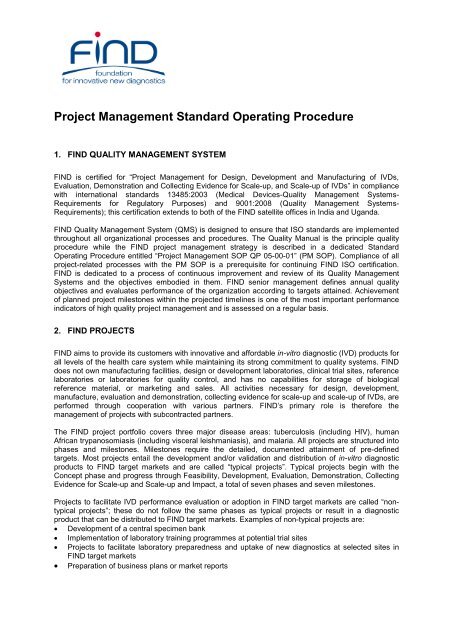

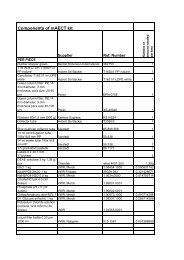
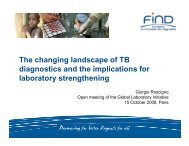
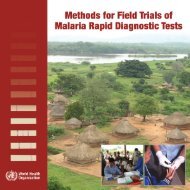
![Download in English [pdf 2Mb] - Foundation for Innovative New ...](https://img.yumpu.com/49580359/1/184x260/download-in-english-pdf-2mb-foundation-for-innovative-new-.jpg?quality=85)

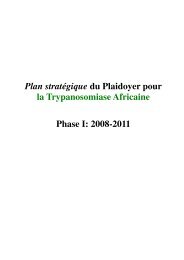
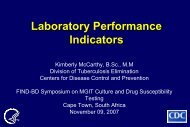
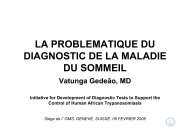
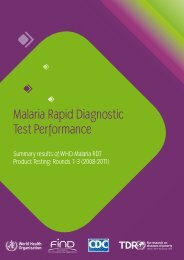
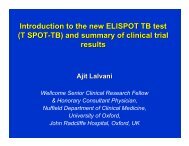
![New laboratory diagnostic tools for tuberculosis control [.pdf]](https://img.yumpu.com/43339906/1/190x135/new-laboratory-diagnostic-tools-for-tuberculosis-control-pdf.jpg?quality=85)
